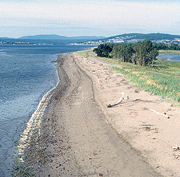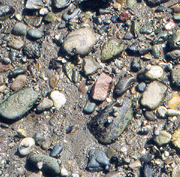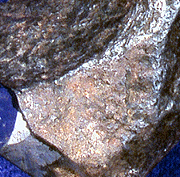Official Name:
Penouille, name of the point of land on the Gaspé Peninsula where the meteorite was found.
Location:
On a beach in Forillon National Park, one kilometre south of the village of Penouille, on the Gaspé Peninsula, in Quebec, Canada.

Enlargement
The small peninsula of Penouille, reaching out into the Gaspé Bay. |
|

Enlargement
Young Christian noticed the small iron meteorite among rocks like these exposed at low tide. |
|
Fall or Find:
Penouille is a find, but the meteorite had not been lying on the ground very long when it was found. Scientists determined this by examining zones under its surface that were affected by the heat as the parent meteoroid passed through the atmosphere.
Date:
Summer 1984 - the exact date is not known.
Mass Recovered:
72.5 grams
Number of Fragments:
One small ellipsoid-shaped fragment was found. The meteorite is 4.8 centimetres long by 3 centimetres wide by 2 centimetres high.
Circumstances:
An 11-year-old boy, Christian Couture, discovered the Penouille meteorite on a beach at low tide while vacationing with his family on the Gaspé Peninsula. The object's density and magnetic properties caught the young collector's attention.
History:
Christian Couture kept the meteorite for ten years. He decided to have it analyzed following the media coverage of the Saint-Robert meteorite fall. He went to the Planétarium de Montréal in 1994 to have his find authenticated. The astronomers identified it as a meteorite, and it was sent to the Geological Survey of Canada for full analysis. The young man decided to sell his meteorite to the Planétarium de Montréal.
Type:
Iron meteorite
Class:
Medium octahedrite. The kamacite bands are 0.88 millimetres thick.
Group:
Penouille is in group IB. These meteorites are thought to come from small concentrations of melted iron-nickel that form near the surface of asteroids due to the heat released after impact by a smaller object.

Enlargement
The Penouille octahedrite is one of the jewels of the Planétarium de Montréal collection. |
|
Composition:
Penouille is mostly composed of iron. Its second most abundant constituent is nickel, which makes up 9.4% of the meteorite's volume. Trace elements in Penouille include cobalt (365 parts per million), gallium (63 ppm), iridium (3.66 ppm), and gold (1.98 ppm).
Scientific contribution:
Chemical analysis of certain elements in the Penouille meteorite made it possible to confirm that it was a new meteorite. Penouille's unique chemical signature made it clear that this was not a fragment from another fall, transported to the beach by waves or humans. To carry out the tests that were done, a 3-gram fragment was sawed off the end of the meteorite.
Comments:
Meteorites that are found by chance without their fall being observed are usually iron meteorites. The surface of these objects is very different from the surface of terrestrial rocks. Young Christian's exploit was nevertheless remarkable-he spent hours and hours examining the rocks uncovered by the low tide. We remind our readers, however, that collecting specimens (animals, plants, minerals, or archaeological artifacts) in national parks of Québec and Canada is prohibited by law.
Part of the Planétarium's collection:
Yes